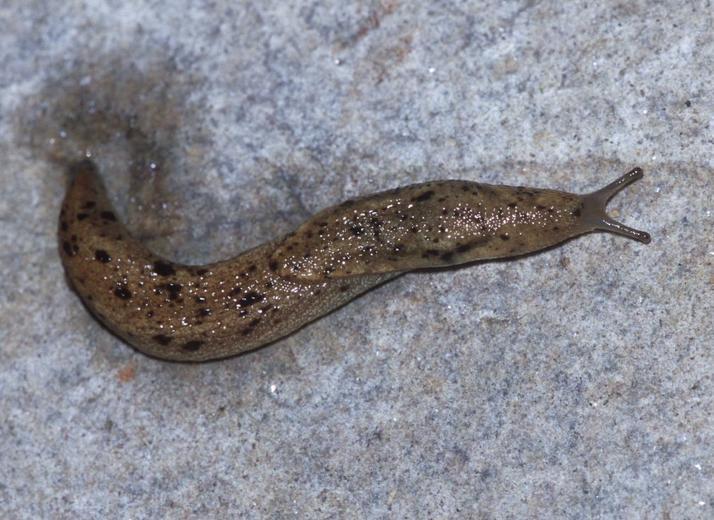Low-
Moderate
The population size of the spotted taildropper is critical and the trend is unknown.
Description and Range
Physical description
The spotted taildropper is a somewhat large slug, generally 2 to 3 inches (50 to 75 millimeters). This slug is light brown, and its mantle and tail are covered with black spots of irregular size and shape. Taxonomic note: The spotted taildropper slug (P.v. pardalis) has not been formally described as a subspecies.
Ecology and life history
This slug has been found in leaf litter under bushes in mature conifer forest with a high degree of diversity in plant and mollusk species. It is also found in moist, mature conifer and deciduous forest habitats or in the coastal fog zone adjacent to the ocean.
There is no specific information available about the life history of the spotted taildropper.
Like most terrestrial gastropods, taildroppers are hermaphroditic, having both male and female organs. Self-fertilization has been demonstrated in some species of gastropods, but cross-fertilization is the norm.
Slugs are generally oviparous (egg-laying). Eggs of Prophysaon slugs are laid in clusters in cool damp spots including under logs or pieces of wood on the shaded forest floor. Slugs are generally oviparous (egg-laying). Eggs of Prophysaon slugs are laid in clusters in cool damp spots including under logs or pieces of wood on the shaded forest floor.
Slugs are preyed upon by a variety of vertebrates and other invertebrates. If threatened, the taildropper can drop its tail as a means to escape some predators.
Geographic range
A quite rare subspecies from a very limited range in Pacific County, Washington. It is considered a rare spotted form of the scarletback taildropper, a common slug of western Washington and western Oregon forests. May or may not also occur in northwestern Oregon. No large populations are known.
Climate vulnerability
Sensitivity to climate change
Low-
Moderate
There is very limited information regarding the sensitivity of Spotted taildroppers to climate change and limited information available regarding their life history characteristics. Their main sensitivity is likely to be driven by changes in their preferred habitat – mature conifer forests with moist ground. Increases in temperature and decreases in summer rainfall are likely to lead to increased risk of severe fires, which would destroy habitat for this species. Declines in habitat quality could also lead to fragmentation of populations and eventual population declines, particularly because documented populations of this species are already very small.
Exposure to climate change
Moderate
- Increased temperatures
- Reduced soil moisture and/or changes in precipitation
- Altered fire regimes
Conservation
Conservation Threats and Actions Needed
- Resource information collection needs
- Threat: Lack of data on current status and distribution .
- Action Needed: Determine distribution and population status.
- Fish and wildlife habitat loss or degradation
- Threat: Residential and commercial development and recreation; Farming, construction, and agriculture.
- Action Needed: Habitat protection and restoration. Minimize or eliminate conversion of habitat. Monitor and assess activities for impacts on the spotted taildroppers and its habitat.
See the Climate vulnerability section for information about the threats posed by climate change to this species.
Resources
References
Burke, T. E. 2013. Land Snails and Slugs of the Pacific Northwest. Oregon State University Press, Corvallis, OR. 344pp.
Frest, T.J. and E. J. Johannes. 2000. Baseline Mollusk Survey of Southwest Oregon (Rogue and Umpqua Basins). Deixis Consultants, Seattle, Washington. Oregon Natural Heritage Program, Portland Oregon.
